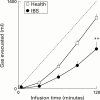Impaired transit and tolerance of intestinal gas in the irritable bowel syndrome
- PMID: 11115817
- PMCID: PMC1728167
- DOI: 10.1136/gut.48.1.14
Impaired transit and tolerance of intestinal gas in the irritable bowel syndrome
Abstract
Background: Patients with irritable bowel syndrome (IBS) frequently complain of excessive gas but their fasting volume of intestinal gas is apparently normal. We hypothesised that the pathophysiological mechanism involved may be impairment of intestinal gas transit.
Aim: To investigate intestinal gas transit and tolerance in IBS patients compared with healthy subjects.
Methods: A gas mixture (N(2), O(2), and CO(2) in venous proportions) was infused into the jejunum of 20 patients with IBS and 20 healthy controls at 12 ml/min for four hours. Gas evacuation, initially flatus from the anus (two hours) and then intrarectally (two hours), was continuously recorded. Symptom perception (0-6 scale) and abdominal distension were measured at 10 minute intervals.
Results: After two hours of external gas (flatus) collection, 18 of 20 IBS patients had developed gas retention (>400 ml), increased gastrointestinal symptoms (score >3), or abdominal distension (>3 mm girth increment) compared with only four of 20 control subjects. During intrarectal gas collection, 13 of 17 patients still exhibited abnormal responses.
Conclusion: A large proportion of patients with IBS can be shown to have impaired transit and tolerance of intestinal gas loads. This anomaly may represent a possible mechanism of IBS symptoms, specifically pain and bloating.
Figures



References
Publication types
MeSH terms
Substances
LinkOut - more resources
Full Text Sources
Medical
